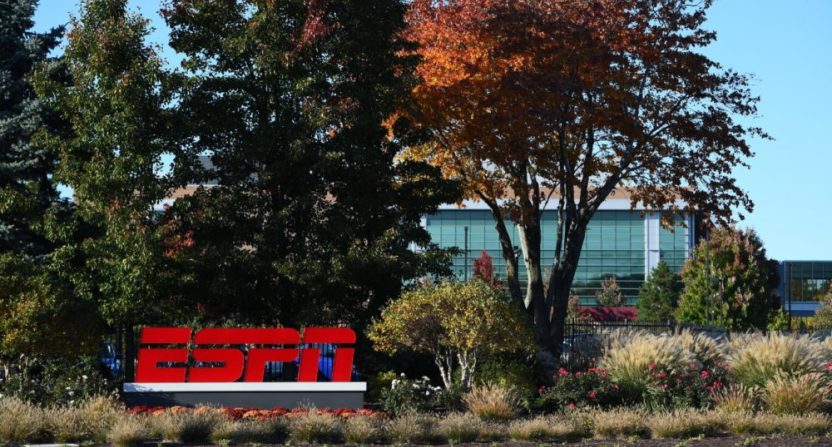The narrative of Disney’s quarterly earnings calls’ discussion of ESPN has changed significantly this year. In late 2016 and through all of 2017, Disney’s overall year-over-year growth was often below expectations, and declining subscribers and lower revenues at ESPN were often cited for that. But 2018 has told a different story, with ESPN holding reasonably steady in Q1 (especially compared to the struggles at ABC), seeing a slight downturn in Q2 (but one that was mostly about higher programming costs thanks to the timing of College Football Playoff games), and then rising significantly in Q3. Disney released their Q3 results Wednesday, and what that release had to say about ESPN was quite interesting:
Cable Networks revenues for the quarter increased 2% to $4.2 billion and operating income decreased 5% to $1.4 billion. Lower operating income was due to a loss at BAMTech and a decrease at Freeform, partially offset by an increase at ESPN.
…The increase at ESPN was due to affiliate revenue growth and the comparison to severance and contract termination costs incurred in the prior-year quarter, partially offset by higher programming costs and a decrease in advertising revenue. Affiliate revenue growth reflected contractual rate increases, partially offset by a decline in subscribers. The programming cost increase was primarily due to a contractual rate increase for NBA programming. Lower advertising revenue was due to a decrease in impressions from lower average viewership, partially offset by higher rates. Advertising revenue was adversely impacted by one less NBA final game.
So ESPN’s bottom line is doing better even with increased programming costs. Of course, some of that should be taken with a grain of salt given the “comparison to severance and contract termination costs”: they didn’t conduct any major layoffs this calendar year, so they haven’t had to pay as much on that front, and that’s not exactly a reliable continuing source of benefits. (But by the same token, last year’s numbers were worse than usual thanks to those one-time costs, so this may be closer to the new baseline.) But it’s also notable that the worries about subscriber loss have diminished, with Disney CFO Christine McCarthy saying on the earnings call that cord-cutting from traditional cable and satellite packages isn’t proceeding as quickly as it was and that ESPN is also seeing growth from digital multichannel programming distributor (MVPD) packages like SlingTV and DirecTV Now.
“We’re encouraged with the trends we’re seeing, a slowdown in the decline of traditional subscribers and rapid growth in digital MVPD subscribers,” McCarthy said.
And ESPN is doing well on another front with their own direct-to-consumer service, ESPN+. While not offering numbers, Disney CEO Bob Iger said that service is picking up subscribers faster than projected following its April launch, and part of that’s about the different programming they’ve been able to add (including Italy’s Serie A soccer league, announced earlier Tuesday). He also said there may be some more programming deals to come for ESPN+, even though many top-tier rights are already locked up.
“Subscriber numbers are exceeding our expectations,” Iger said. “We had relatively moderate expectations…in part because of the nature of the product offering. But we’ve added nicely to the product offering. …We feel very good about our position. We’ll continue to look opportunistically at what products will be available.”
Iger also said that they’ve seen good rates of subscribers sticking around after the seven-day free trial, and good rates of people sticking with the service from month to month.
“The conversion from free to paid has been promising.”
Of course, there’s the question of what Disney is spending on rights and technology for ESPN+ is worth it, and the “loss at BAMTech” mentioned above reflects ESPN+ costs (BAMTech is now rolled into the cable networks segment alongside ESPN). But Iger said the key aspect of direct-to-consumer programming like ESPN+ is in the long-term, setting Disney up for the future. And he said that it’s gone very well so far.
“It’s a marathon, it’s not a sprint. The product seems to be working quite well technologically. …We’re happy with it.”
The latest
- Exclusive: Famed travel baseball coach Nelson ‘Coach Nelly’ Gonzalez talks partnering with Perfect Game for podcast
- Jason Kelce hire solidifies ‘Monday Night Football’ as ESPN’s premier program
- Paul Bissonnette and Anson Carter on covering former NHL on TNT colleague Rick Tocchet: ‘It’s been easy to pump his tires.’
- Exclusive: Michael Davies is stepping back from regular Men in Blazers appearances
“We also know that traditional distributors are very interested in distributing our DTC products, as they do right now for Netflix. We actually believe they can potentially live side by side in a negotiation and not necessarily create issues. There’s a reality in the business…SVOD over-the-top products are here to stay.”
Another question revolved around the regional sports networks Disney is acquiring from Fox, but then selling off as part of the Justice Department’s conditions for their purchase of Fox assets. Iger said that even though the Fox deal hasn’t fully closed yet, Disney is already in talks with RSN buyers.
“The process of selling them is actually already beginning, conversations are starting, interest is being expressed. It’s likely we’ll negotiate a deal to sell them but the deal will not be consummated or fully closed until the overall 20th Century Fox deal closes.”
Overall, ESPN and Disney’s sports properties received far less attention on this call than they had in the past, thanks to the positive results and thanks to other key things to ask about (such as that Disney subscription service and the Fox deal). And that’s probably a good sign for ESPN; they’re no longer a scapegoat to blame for less-than-anticipated results. And they don’t have to deal with the high one-time costs of laying tons of people off. At least not this quarter.







